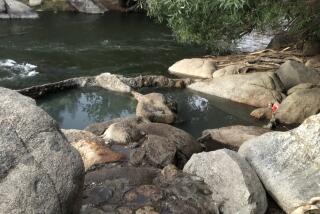It was a flourishing health spa and...
- Share via
It was a flourishing health spa and resort in the 1920s, but it is all but forgotten today. All that remains of White Point Hot Springs, a cove tucked under the bluffs near the foot of Western Avenue in San Pedro, are the sea-battered concrete foundations of a saltwater swimming pool and a pieced-together fountain covered with graffiti.
The bluffs, above Royal Palms Beach, were called White Point, some say, because of the white quartz once found in the cliffs. But romantics maintain that the name comes from a British sailor named White, who jumped ship, swam ashore and lived as a hermit there before finding work as a cowhand. Roman Sepulveda, who held title to this portion of the old Rancho de los Palos Verdes, called the area White Point as early as 1900.
At the turn of the century, immigrant fishermen from Japan harvested the bountiful abalone from the waters off the Palos Verdes Peninsula. They shipped tons of the shellfish to the Far East and to Los Angeles’ Little Tokyo. Within a few years, the abalone were fished out, but an even greater attraction was discovered--sulfur springs.
Tamiji Tagami, an immigrant Japanese vegetable farmer from West Los Angeles, often soaked his aching rheumatic body in the hot, soothing springs. In 1917, he and his brother, Tojuro, leased the beachfront property from Sepulveda, and with financial backing from merchants in Little Tokyo, they built the seaside resort that featured a hotel, a ballroom, a bathhouse, two restaurants, a children’s swimming pool, bird and monkey cages and a few slot machines and card tables.
Sumiko Seo Seki, whose father had started farming at White Point in 1913, recalled seeing one businessman who owned a soft drink company make his deliveries, collect his payments and promptly gamble them away.
In 1922, Sepulveda, who admired the Issei (first-generation Japanese-American immigrants), built an Olympic-size saltwater swimming pool that was warmed by one of the sulfur springs.
A sprinkling of health-seekers began to take advantage of the spa’s healing climate and sulfur springs. Physicians sent patients there, and newlyweds spent romantic honeymoons at the resort, relaxing in the soothing spas. The resort also became a location for movies, including a Dick Tracy serial with Ralph Byrd.
Kelp beds made White Point a fisherman’s paradise. Fishing boat captain Mitsuo Endo, who lived on Terminal Island, bought the Sierra, an old lumber schooner, in 1926, outfitted it as a barge and moored it about a mile out to sea in front of the resort. Endo then built a pier at the southern end of the resort and ran water taxis out to the fishing barge.
Elaborate picnics and dances, were held each Sunday during the summer. Japanese-Americans from Little Tokyo would venture south to the beach to play games and socialize with friends. Tagami would provide some picnickers with free transportation in his open-air bus.
In 1932, Japan’s Olympic track and rowing teams, feted with Japanese food and stage shows, rested at the resort in preparation for the Los Angeles Games.
A year later, the Long Beach earthquake partially sealed some of the springs. As the Depression deepened, the resort’s hotel went out of business. In 1941, FBI agents in black cars and snap-brim fedoras rounded up the Tagami family, Endo, and other Japanese-Americans and sent them off to World War II internment camps.
The military took over White Point, and some reports say that the hotel, restaurant and bathhouse were used for gunnery practice.
Endo’s barge was towed away, but an underwater plaque honoring the early Japanese-American fishermen is bolted to the rocks about 100 yards offshore, where the end of the pier once rested. It is known today as Issei Cove.
Ten years after Tagami built his resort, Sepulveda built the Spanish-style Royal Palms Hotel, which barred Japanese-Americans. Its oceanfront golf course folded in 1933, and its clubhouse burned in 1955. The club’s gatehouse is now a private residence.
Today, the cove has hundreds of hydrothermal springs stretching from the shallow shoreline out to a depth of about 45 feet. The sulfurous water is 82 degrees, 20 to 30 degrees warmer than the seawater. It remains a favorite diving spot and underwater park.
More to Read
Sign up for Essential California
The most important California stories and recommendations in your inbox every morning.
You may occasionally receive promotional content from the Los Angeles Times.










